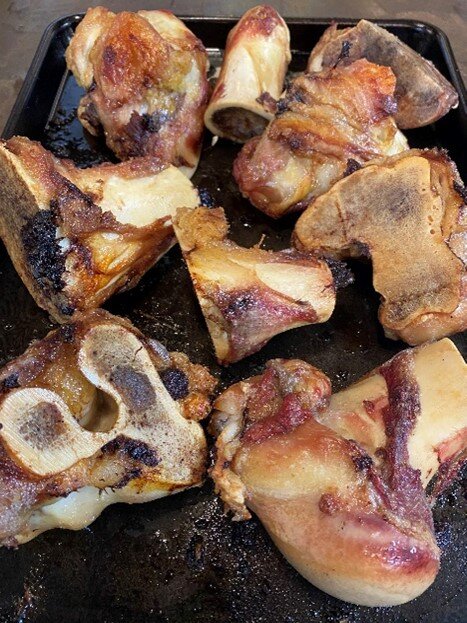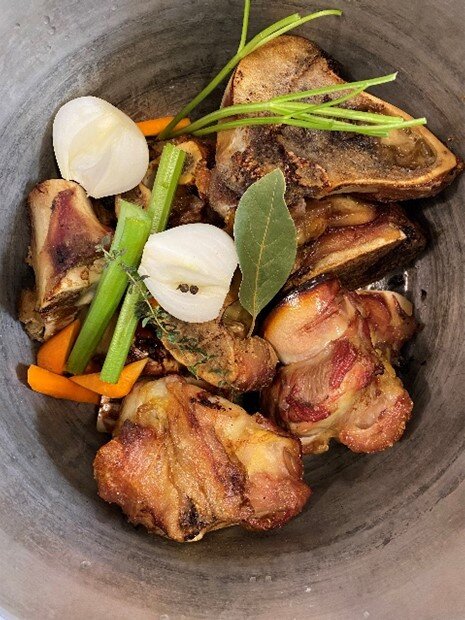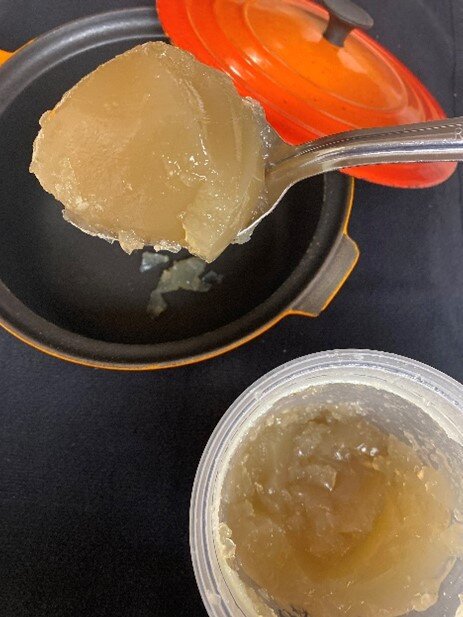Bone Broth
By Saskia Poulos, Chef and Organic Farm Assistant at the Oak Spring Garden Foundation
The difference between a stock and a broth really boils down to how much meat is on the bones. A stock is made from bones that have been essentially stripped clean of meat, whereas a broth is made with meatier bones (and, generally, with more vegetable mirepoix). A bone broth is essentially a stock, loaded with health benefits due to the low and slow cooking technique that draws the collagen out of the bones and into easily digestible amino acids.
Bone broths have been lauded for their vitamin and nutrient content; digestion and gut health support; assistance in anti-aging molecules production; ability to aid sleep; and potential protection of the joints. Our beef bones are loaded with collagen and marrow and make an unbelievable collagen-rich bone broth. Throwing a splash of vinegar in with the water will help extract as much nutrient as possible from the marrow. These bones have a lot to give, and can be used more than once—the French call this kind of stock a remouillage (literally translating to ‘rewetting’). After you have strained off your stock, put the bones back in the pot and fill them with COLD water, repeating the process described below. You will be shocked at how much more these bones have to give!
NOTE: Keep in mind these ingredients are flexible, and do not stress if you don’t have all the herbs or vegetables listed. It will still be delicious. Save the trimmings from your vegetables and herbs in the days leading up to bone broth day—stay away from brassicas (cabbage, cauliflower, etc.), stick to the classic onion (including all alliums—scallion, shallot, and garlic), celery, carrot mirepoix. Additionally, herb stems like parsley, thyme, rosemary, cilantro all work very well.
Ingredients:
3-4 # Beef bones
1 peeled carrot, cut into 1” pieces
1 onion, peeled and halved
1 celery stalk, cut into 1” pieces
10 black peppercorns, whole
1 bay leaf
Additional herbs and stock trimmings
1 oz white vinegar
Preparation:
Preheat oven to 400 F
Rinse thawed or fresh bones with cold water to remove blood and other impurities.
Roast in the oven for 20- 30 minutes until golden brown.
Place bones in a large pot. Discard excess fat carefully (it will be very hot). Using a rubber spatula or a wooden spoon, scrape the bits that have stuck to the pan, using a bit of water to loosen the fond. This is the French word for “base;” and the fond will give your stock more flavor. Do not use any burned bits in your stock.
Add your vinegar, vegetable mirepoix, peppercorns, bay leaf and any additional herbs or vegetable scraps you may have.
Cover your bones, mirepoix and aromatics with COLD water. This will probably take about two gallons of water. Make sure you cover the base with at least three inches of water, and that you are at least two inches below the top of the pot to account for expansion and boiling. It is very important to start with cold water. As the water heats up, it will trap impurities and force them to rise to the surface, ensuring a beautiful clear broth.
Bring the broth to a full boil, then immediately turn down to a bare simmer. Simmer for 6-10 hours.
Strain, cool, and freeze in containers appropriate to the volume at which you consume the broth. Keep the bones if you wish to make a remouillage (see description in the first paragraph).
This broth is loaded with collagen, and will set up as it cools! It will melt back to a beautiful golden liquid when brought to a boil. There is no salt in this recipe, so keep in mind you will have to season your broth to taste.



